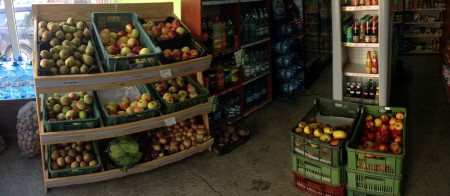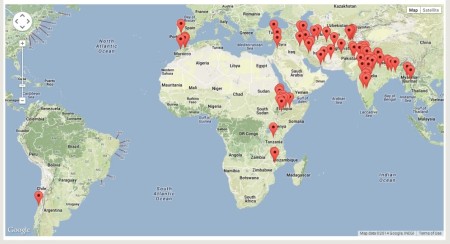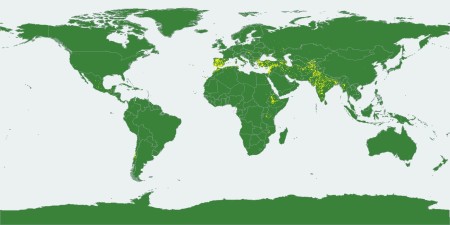- New database on the adoption of modern varieties. No doubt will eventually include the ones coming out of this shiny new rice regional hub in Burundi.
- Useful summary of what’s happening in agricultural biodiversity in Georgia. No mention of ITPGRFA ratification, alas. You can find previous editions of the newsletter of the CGIAR Regional Program for Sustainable Agricultural Development in Central Asia and the Caucasus here.
- CSIRO come up with map of where and how fast species will move due to climate change.
- And Google Earth now has the underlying climate data you need to do that kind of analysis.
- World Congress on Agroforestry off the ground. You can follow on Twitter, #WCA2014. Also, you can read the blog. Do you remember when this type of thing didn’t even have an RSS feed?
- Did we miss this thing of perennial grain breeding at the Land Institute when it came out a year ago?
- Nice long podcast and Q&A from the Bishop Museum on the footprint Hawaiians left on their islands before contact. Great stuff on GIS analysis of suitability of ancient landscapes for taro and sweet potato. And, coincidentally, an equally long video clip on Pacific island landscapes more generally, and how they shaped the culture (and agriculture) of the Polynesians.
- ILRI DG chides The Economist on article suggesting that the only way to decrease livestock emissions is to go industrial: “There simply is no moral equivalent between those making poor food choices and those with no food choices at all.”
- New EU project on Russian dandelion does not seem to include boffins who recently turned off the rapid polymerization gene. And will they use the right species? And do some ex situ conservation? I’m not holding my breath on that last one.
Brainfood: Genomics trifecta, Ex/in situ, Oat disease resistance, Drying beads, Biodiversity assessment, Maize models, Trees & nutrition, NTFP, Fortification
- Maintaining Food Value of Wild Rice (Zizania palustris L.) Using Comparative Genomics. Cultivated cultivated rice assists in the breeding of cultivated wild rice. If you see what I mean.
- Mining the Genus Solanum for Increasing Disease Resistance. The key is distinguishing the alleles from the paralogs.
- Genetic Dissection of Aluminium Tolerance in the Triticeae. And the trifecta from the Genomics of Plant Genetic Resources book. Rye has most, barley least, and we know how they do it.
- Dual Threats of Imperiled Native Agroecosystems and Climate Change to World Food Security: Genomic Perspectives. Genebanks are necessary but not sufficient.
- Identification of new sources of resistance to powdery mildew in oat. In the wild species, natch.
- Optimum ratios of zeolite seed Drying Beads® to dry rice seeds for genebank storage. 1:1 by weight.
- The Biodiversity Forecasting Toolkit: Answering the ‘how much’, ‘what’, and ‘where’ of planning for biodiversity persistence. Yeah, but will it work with agricultural biodiversity?
- How do various maize crop models vary in their responses to climate change factors? Enough to make using an ensemble best, not enough to doubt that temperature will be the main factor affecting yields by the end of the century.
- Dietary quality and tree cover in Africa. More trees, more dietary diversity, more fruit & veg consumption, though up to a point.
- The importance of local forest benefits: Economic valuation of Non-Timber Forest Products in the Eastern Arc Mountains in Tanzania. $42 million a year, spread over 2000 households.
- Fortification: new findings and implications. It’s worked in the US for some nutrients, but not for others, and in some case we don’t understand how and why. We know in other cases it is unlikely to work. Nutritionists have to work together with plant breeders. And, we would add, the agricultural sector in general.
The apple of Poland’s eye
You may have noticed a certain slackness in our blogging last week. That’s because we were both travelling for work, Jeremy holed up at an undisclosed location with lots of copy and a red pen, myself in Warsaw, trying to drum up support for genebanks. It was my first time in Poland, and much too short a visit, but I learned a lot. Like that Poland is a huge apple exporter. It also, and perhaps not coincidentally, has a lot of apple diversity, and Poles are very proud of it. Even a small corner grocery shop in Warsaw will have half a dozen and more distinct varieties on display.
That, I was told, is at least partly due to the tireless efforts of the famous apple breeder Prof. Szczepan Pieniążek, founder and long-time head of the Research Institute of Pomology in Skierniewice. The apple genebank there has maybe a thousand accessions still. Prof. Pieniążek has obviously left quite a legacy, despite being, if I understand the Google Translate rendition of his Polish Wikipedia entry, a proponent of quasi-Lamarckian theories, after the fashion of the equally famous Russian breeder Ivan Vladimirovich Michurin. I guess, in breeding, practice is much more important than theory.
Brainfood: Cucumber diversity, Micronutrients in Africa, Natural enemies, Ag expansion, Food security & trade, Chinese forages, Frafra potato, Rayada rice, Persea agroforestry, European oats, Agrobiodiversity & health
- A genomic variation map provides insights into the genetic basis of cucumber domestication and diversity. Four geographic groups, bottleneck not too bad. Opportunity for breeding for better nutritional value. But I suspect that’s a low bar.
- Dietary mineral supplies in Africa. Zn seems to be the lowest hanging fruit, as it were. I wonder if above’s super-cucumbers would help.
- Mechanisms for flowering plants to benefit arthropod natural enemies of insect pests: Prospects for enhanced use in agriculture. If you chose the right plants to plant, you can boost biological control of insect pests on farms.
- Agricultural expansion and its impacts on tropical nature. Roads will lead to increased conversion of natural ecosystems to agriculture in South America and Sub-Saharan Africa. Sustainable intensification is the answer.
- From Food Insufficiency towards Trade Dependency: A Historical Analysis of Global Food Availability. If most of us have more food now, it’s because of trade.
- Technical challenges in evaluating southern China’s forage germplasm resources. Nothing they can’t handle, clearly.
- Sustaining Frafra potato (Solenostemon rotundifolius Poir.) in the food chain; current opportunities in Ghana. Better varieties and processing. Where have I heard that before? Oh yeah, in every single paper on neglected crops.
- Rayada specialty: the forgotten resource of elite features of rice. It’s a weird variant of deepwater rice from Bangladesh with possible enhanced stress tolerance due to longer root system.
- Persea schiedeana: A High Oil “Cinderella Species” Fruit with Potential for Tropical Agroforestry Systems. Superior genotypes of this neglected avocado relative identified in fairs in Mexican region, and targeted for vegetative propagation and participatory breeding.
- Quality characteristics of European avena genetic resources collections. The modern varieties are better, but that doesn’t mean the old ones are useless.
- Nutrient Intake, Morbidity and Nutritional Status of Preschool Children are Influenced by Agricultural and Dietary Diversity in Western Kenya. Low food variety is associated with stunting. Kinda sorta.
Infrequently asked questions on the chickpea mini core
![]() You may have noticed that a recent Crop Science paper by various ICRISAT staff, entitled “Mini Core Collection as a Resource to Identify New Sources of Variation” 1 and focusing on chickpea, has been attracting a certain amount of media interest. In brief, Hari Upadhyaya of the ICRISAT genebank and his co-workers evaluated a set of 211 chickpea accessions from the genebank for resistance to a whole slew of stresses, caused by both environmental factors (abiotic) and pests and diseases (biotic), and picked out some real winners. Those 211 chickpeas were not chosen at random. They were carefully selected to reflect the overall diversity of the collection of some twenty thousand samples managed by ICRISAT. Hari explains the rationale for this on the genebank’s chickpea web pages (in fact, he has done similar work on all his mandate crops):
You may have noticed that a recent Crop Science paper by various ICRISAT staff, entitled “Mini Core Collection as a Resource to Identify New Sources of Variation” 1 and focusing on chickpea, has been attracting a certain amount of media interest. In brief, Hari Upadhyaya of the ICRISAT genebank and his co-workers evaluated a set of 211 chickpea accessions from the genebank for resistance to a whole slew of stresses, caused by both environmental factors (abiotic) and pests and diseases (biotic), and picked out some real winners. Those 211 chickpeas were not chosen at random. They were carefully selected to reflect the overall diversity of the collection of some twenty thousand samples managed by ICRISAT. Hari explains the rationale for this on the genebank’s chickpea web pages (in fact, he has done similar work on all his mandate crops):
The main reason for low use of germplasm in crop improvement programs is the lack of information on large number of accessions, particularly, for traits of economic importance which display a great deal of genotype × environment interaction. Brown (1989) introduced the concept of developing core collection, which consist of about 10% of entire collection and represent at least 70% of the genetic variability of the entire collection, as a gateway to the enhanced utilization of germplasm in breeding. Core collection in chickpea has been reported (Upadhyaya et al. 2001). However, it soon became evident that developing core collections will not solve the problem of low use of germplasm, as even the size of core collection could still be large. To overcome this, Upadhyaya and Ortiz (2001) proposed mini core collection concept (consisting of 10% of the core or 1% of the entire germplasm), and developed mini core subsets in chickpea (Upadhyaya and Ortiz 2001).
The extensive evaluation of the chickpea mini core collection described by Hari and his colleagues in the paper, which spanned many sites and several years, allowed them to identify 40 accessions which were resistant to abiotic stresses, 31 to biotic stresses and 6 accessions which were in both groups. Very useful information for any chickpea breeder, who can now request material by name (or rather, accession number) rather than sending vague requests to Hari for material with resistance to this or that. This sort of work by genebanks makes life easier for breeders and researchers, and increases use of the collection. Which everyone wants to see, not least the money people.
However, even if you get hold of a PDF of the original paper, you may still have a few questions. And so we rolled up our sleeves on your behalf and made the necessary journey into Genebank Database Hell.
One question you may have is: what accessions are in the chickpea mini core? The paper doesn’t list all 211, but you can get the full list from one of the ICRISAT genebank’s web pages. Just click on the link on that page and you’ll see accession number and country of origin for all 211 accessions.
The obvious next question is: how do I get more information on all those accessions? After all, you may want to do your own analysis of the evaluation results. Well, you could cut and past those accession numbers into ICRISAT’s online genebank database. But as chance would have it, there is an easier way, as USDA has a safety duplicate of the mini core, and a set of ICRISAT’s evaluation results is also online at GRIN. It might not be as bang up to date as what’s in the paper, but it’s a start.
Next: what’s the geographic distribution of the accessions in the mini core. Ok, so for this, you could just have a look at the countries of origin, but really dots on a map would be best, right? That turns out not to be so easy to get, you may or may not be surprised to find. To cut a long story short, you will be able to do it in the next iteration of Genesys, but that’s not public yet. Fortunately, I was able to sneak into the sandbox, and for the 25% or so of the 211 accessions which actually have georeferences, this is the result. You saw it here first, folks.
Compare to the distribution of the third of all 48,000-odd chickpea accessions listed in Genesys (current version) which can be mapped.
Yes, I know it’s a little difficult to compare, but that’s really the best I can do at the moment. One question you may have based on that is to what extent the mini core is representative of the climates from which chickpeas have been collected. But that I really cannot answer at the moment without devoting some serious effort to it.
One last thing, which is a little bit more esoteric, so let me sound a Genebank Wonk Alert. You have been warned. Delve a little deeper into the data on one of those 6 super-chickpeas with a whole bunch of resistances, ICC 14402, and you find that, unlike the other 210, which are all labelled as landraces, this one is described as “Breeding/Research material.” What is its history? It’s a little tricky to piece together, but if you look at the other accession numbers which are associated with that accession, both in the ICRISAT database and on GRIN, you get the impression that it represents a selection from a Turkish landrace, ICC 4490. It’s impossible to prove that from the data available online, but I verified that impression with Hari, and he confirmed it in an email:
…ICC 4490 (P 5924; 88 1-4 Spanish) is a landrace from Turkey and was donated in 1973 to ICRISAT. At ICRISAT this line (ICC 4490) was screened in wilt sick nursery and a wilt resistant single plant was selected from this line. The original accessions was maintained as ICC 4490 and new accession identity ICC 14402 was given to this wilt resistant selection in 1986. WR stand for “Wilt resistant”.
There’s clearly quite a lot on information that hasn’t made the journey from the brains of genebank curators to the relevant databases, or indeed the published literature. That’s a little worrying to me.


